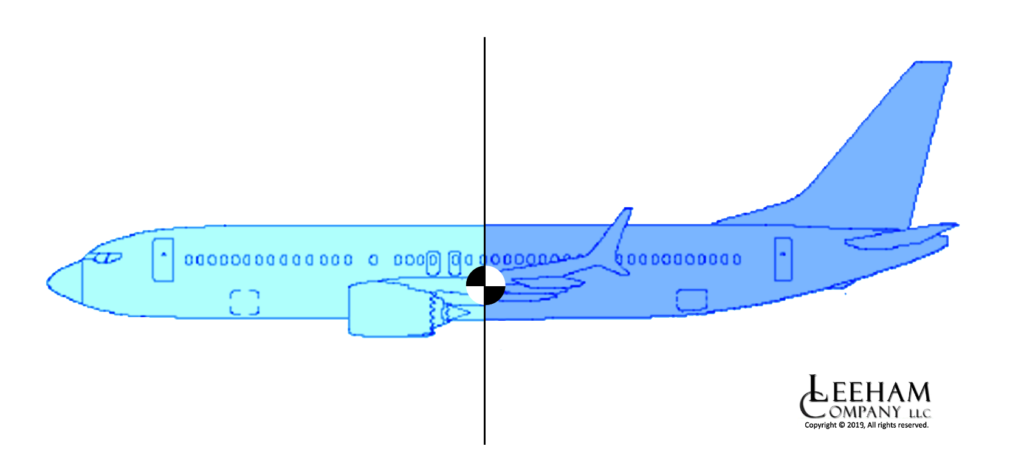Leeham News and Analysis
There's more to real news than a news release.
Bjorn’s Corner: Airliner yaw stability
Feb. 22, 2019, ©. Leeham News: After discussing an airliner’s pitch stability we now turn to the yaw stability. A stable aircraft in yaw means we don’t want the aircraft to wag its tail sideways while flying.
The airliner shall fly straight ahead during take-off, climb, cruise, descent and landing, even when we have problems with an engine and must throttle it back or shut it down on one side.
Yaw stability basics
An aircraft should fly straight ahead regardless of disturbances like side wind, uneven thrust from the engines or when one engine has problems and goes inoperative ( OEI, One Engine Inoperative).
To achieve this stability we must have larger and more effective vertical surfaces behind the center of gravity than ahead of it, Figure 1.
A side wind or a sideslip from the aircraft has the air flowing around the nose, engines and the fuselage (over the top and under the belly). Any smoothly curved surface, be it the nose, fuselage barrel or the engine nacelles, will create a side force on the leeward side from such an angled flow curving around it.
The airflow is then hitting the aircraft with an Angle of Yaw and just like the Angle of Attack creates a suction peak just behind the cockpit of the aircraft in the pitch axis (Figure 2), it will create a suction peak on the leeward side of the forward fuselage. The same happens with the engines.
Taller vertical tails
An aircraft designer, therefore, uses a large and efficient vertical surface to make sure these forces are counterbalanced aft of the center of gravity (the point around which the aircraft moves in flight).
A large vertical tail creates drag and it adds weight. The vertical tail size is, therefore, the minimum size which gives enough “weathercock” stability to the aircraft in all the side force scenarios the aircraft can encounter.
The side force needed is a moment about the center of gravity. Therefore both the size of the vertical tail and its distance from the center of gravity is important. This is also why the shortest member of an aircraft family is the most critical when it comes to yaw stability.
The Airbus A330 is a good example where the shorter A330-200 has a 1m higher vertical tail than the longer A330-300. The short Boeing 747 SP is another example where the vertical tail grew substantially as the aircraft was shortened.
In the next Corner, we will dig deeper into airliner Yaw stability.





So the force of the “weathercock” on the tail has to be greater than the leeward suction peak on the front of the aircraft. What are the “weathercock” forces? What does the pressure distribution look like on the vertical stabilizer in yaw at a small AOA with the rudder extended a few degrees? Is there more pressure on the windward side, or more suction pressure on the leeward side of the stabilizer and rudder?
Hi Ted,
the vertical stabilizer works like a vertical wing. The aerodynamics around this vertical wing is the same as for a horizontal wing. The creation of forces is now in the horizontal plane but they follow the same principles as for the wing. This means the slightest yaw angle of the aircraft will create an overpressure on the windward and suction on the leeward side. This will return the aircraft to straight ahead after a yaw disturbance.
The rudder doesn’t have to move to create this straightening force. We will later look at a dynamic yaw stability problem called Dutch roll which is caused by roll stiffness where the rudder needs to move to counter the instability.
Bjorn: Do swept winglets add anything to the stability allowing a bit less VS?
So the MD-11/737 max type add more?
And do the non winglet types (crank tips) like 787 and 777 need a bit more VS ?
note: One of the dawning moment was when someone wrote that a sail was like a vertical wing, I began to get some of it.
The winglets certainly generate a force when there is a Yaw angle of attack. But as you can see in Figure 1 their moment arm in yaw to the Center of Gravity is short, hence given their small vertical size they will have a small positive influence on yaw stability (as their force is behind the CG). Their influence on roll stiffness and by it Dutch roll will be more important, however.
Thank you.
Better or worse for roll stiffness and affect on Dutch Roll?
A winglet will increase the roll stiffness and by it increase the Dutch roll tendency of the aircraft.
Most interesting.
Ayup, check the taller fin on the SP version of the 747.
(Not to be confused – hah! – with the 747SE which is a standard 747 with some structural improvements for fatigue life in shorthaul service, and perhaps systems capacity increases for more occupants – oxygen for example.)
The taller fin of the SP came in handy for the spasce shuttle-carrying aircraft.
At risk of duplicating what you may say, another approach is a ventral fin, used on the short-body 707 for Qantas. (A 701-100 shortened to reduce weight to increase range.)